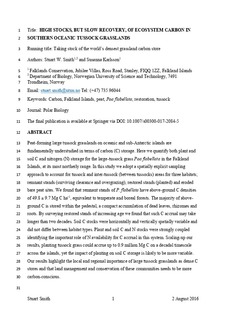| dc.contributor.author | Smith, Stuart | |
| dc.contributor.author | Karlsson, Susanna | |
| dc.date.accessioned | 2019-05-07T10:35:43Z | |
| dc.date.available | 2019-05-07T10:35:43Z | |
| dc.date.created | 2017-02-15T19:45:23Z | |
| dc.date.issued | 2017 | |
| dc.identifier.citation | Polar Biology. 2017, 40 1617-1628. | nb_NO |
| dc.identifier.issn | 0722-4060 | |
| dc.identifier.uri | http://hdl.handle.net/11250/2596770 | |
| dc.description.abstract | Peat-forming large tussock grasslands on oceanic and sub-Antarctic islands are fundamentally understudied in terms of carbon (C) storage. Here we quantify both plant and soil C and nitrogen (N) storage for the large-tussock grass Poa flabellata in the Falkland Islands, at its most northerly range. In this study we adopt a spatially explicit sampling approach to accounting for tussock and inter-tussock (between tussocks) areas for three habitats; remnant stands (surviving clearance and overgrazing), restored stands (planted) and eroded bare peat sites. We found that remnant stands of P. flabellata have above-ground C densities of 49.8 ± 9.7 Mg C ha-1, equivalent to temperate and boreal forests. The majority of above-ground C is stored within the pedestal, a compact accumulation of dead leaves, rhizomes and roots. By surveying restored stands of increasing age we found that such C accrual may take longer than two decades. Soil C stocks were horizontally and vertically spatially variable and did not differ between habitat types. Plant and soil C and N stocks were strongly coupled identifying the important role of N availability for C accrual in this system. Scaling-up our results, planting tussock grass could accrue up to 0.9 million Mg C on a decadal timescale across the islands, yet the impact of planting on soil C storage is likely to be more variable. Our results highlight the local and regional importance of large tussock grasslands as dense C stores and that land management and conservation of these communities needs to be more carbon-conscious. | nb_NO |
| dc.language.iso | eng | nb_NO |
| dc.publisher | Springer Verlag | nb_NO |
| dc.title | High stocks, but slow recovery, of ecosystem carbon in southern oceanic tussock grasslands | nb_NO |
| dc.type | Journal article | nb_NO |
| dc.type | Peer reviewed | nb_NO |
| dc.description.version | acceptedVersion | nb_NO |
| dc.source.pagenumber | 1617-1628 | nb_NO |
| dc.source.volume | 40 | nb_NO |
| dc.source.journal | Polar Biology | nb_NO |
| dc.identifier.doi | 10.1007/s00300-017-2084-5 | |
| dc.identifier.cristin | 1451031 | |
| dc.description.localcode | This is a post-peer-review, pre-copyedit version of an article published in [Polar Biology]. The final authenticated version is available online at: https://doi.org/10.1007/s00300-017-2084-5 | nb_NO |
| cristin.unitcode | 194,66,10,0 | |
| cristin.unitname | Institutt for biologi | |
| cristin.ispublished | true | |
| cristin.fulltext | preprint | |
| cristin.qualitycode | 1 | |
